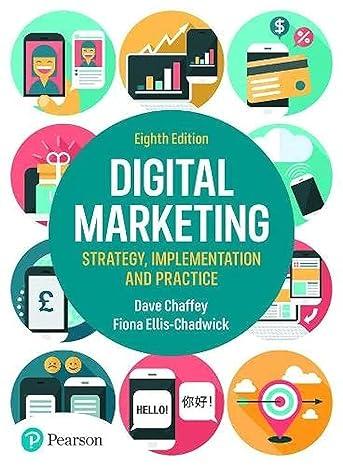Global Action Plan UK (GAP, Globalactionplan.org.uk) is a charity formed in 1993 that aims to help people
Question:
Global Action Plan UK (GAP, Globalactionplan.org.uk) is a charity formed in 1993 that aims to help people live more sustainable lives by connecting what is good for individuals (health and well-being) with what is good for the planet (environmental action). They have a simply stated Vision and Mission to communicate their aims:
• Vision: A green and thriving planet where people enjoy their lives within the earth’s resources.
• Mission: Inspiring change by making connections between what is good for us and what is good for the planet.
GAP recognises that to achieve change requires radical change in society and business beyond actions consumers may take. It also requires policy makers in governments to change their approach, and that businesses will need to take action too:
The climate and ecological crisis calls for a radical rethink about how we live our lives. Conversations about plastic straws aren’t going to crack it. To see response at the required scale we need to mobilise government, business, the media and the public to all step up to play their part.
We bring people together to inspire each other to go further and exert their voice to ensure policy makers and organisations play their part. We tackle issues which require the mobilisation of mass movements in order to see change. And which demand fundamental conversations about how we live our lives. These issues are united in their need for radical change and solving them would be good not only for our planet but also for us.
GAP UK has four principles that govern how it operates, which are featured in its Trustees report:
• We challenge the norm – Radical change is needed – not incremental tweaks. We dare to think big and re-imagine how we live and work; to bring about real shifts in human behaviour and tackle systemic issues not symptoms.
• We get stuff done – We work hard to have a real impact in everything we do. We aren’t happy with talk, we want action, today.
• We share openly – We are honest, straight talking and open. Whether data, ideas, projects or tools we seek to share and collaborate for bigger impact.
• We look out for employees – We believe that what is good for us is good for the planet, and vice versa.
We advocate for change to benefit the most vulnerable and avoid scaremongering whenever we make the case for action.
Campaigning activities
To help support change, GAP has defined two building blocks around which campaigning activities are devised, the Compassion not Consumerism Movement and the Clean Air Movement. Consistency in communications is controlled through brand guidelines, which are flexible enough to work across print and online communications (social media and email). Tone-of-voice guidance isn’t used, however.
Within the Compassion not Consumerism Movement campaigns have included:
• Dirt is Good – Working with Unilever as the thought leadership partner for Persil’s Dirt is Good project.
• Transform our World – an online, centralised, quality-rated resource hub to help teachers to bring environmental action into the classroom, supported by the #iwill campaign.
• #Idontbuyit – the campaign calls out the forces that drive hyper-consumption and exposes the marketing techniques that are harmful to young people and the planet. #Idontbuyit supports young people and parents to challenge the pressure to consume and aims to help individuals ‘build a resilience to our toxic culture of looks, likes and shopping’. In 2010 an Instagram campaign created 5,000,000 impressions or opportunities for teenagers to see content related to the campaign.
Within the Clean Air Movement campaign activities include:
• Clean Air Day – the United Kingdom’s largest air pollution campaign, engaging thousands of people at hundreds of events, and reaching millions more through the media. It is promoted via a microsite (Cleanairhub.org.uk). In 2014, Clean Air Action Day aimed at motivating drivers to switch their engines off, resulting in #noidling trending on Twitter. In 2019, 400,000 participants got involved in Clean Air Day and 600 events were held around the country. 250 official supporter organisations and 3,700 participating organisations came together to work on air pollution.
20,000 news and broadcast items carried Clean Air Day stories, with an equivalent advertising value of £11 million. Media coverage included live interviews on Sky and BBC Radio, articles in The Times and Daily Express and a raft of local stories. Online, print, broadcast and social media coverage (380 million opportunities to view) provided more than 1 billion opportunities to view and learn about air pollution.
• Air Pollution Calculator – encourages people to work out their individual contribution to air pollution in the United Kingdom and find out what they can do to reduce emissions and protect their health.
• Business for Clean Air – developed by the Business for Clean Air Taskforce, Business for Clean Air (BfCA)
is a voluntary initiative that companies can join to signal their commitment to addressing air pollution.
• Cycle21 – The campaign hook was that it takes 21 days to build a habit, according to Phillipa Lally, a health psychology researcher at UCL. The Youth Panel at Global Action Plan created the challenge and campaign with this in mind..............
Questions
1 Which techniques does GAP use to ensure the consistency and effectiveness of its campaign communications?
2 How does GAP encourage change through seeking to influence different types of stakeholders?
3 Using the example of the Clean Air Day, #Idontbuyit, Cycle 21 or other campaigns, assess the media mix used to reach and influence audiences and how their effectiveness is assessed.
Step by Step Answer:

Digital Marketing Strategy Implementation And Practice
ISBN: 247145
8th Edition
Authors: Dave Chaffey, Fiona Ellis Chadwick





